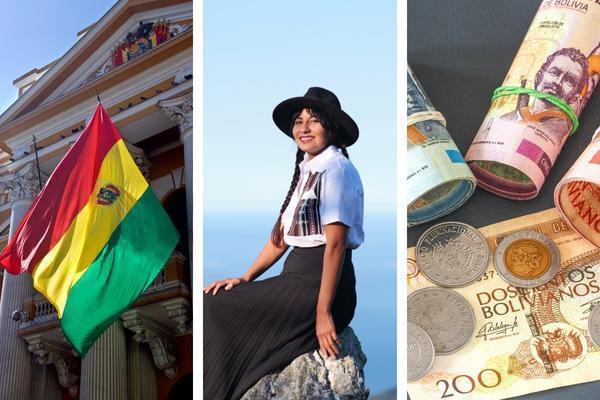
Bolivia is a landlocked South American country bordered by Brazil, Paraguay, Argentina, Chile, and Peru. The massive Andes mountains, with steep slopes and snow-capped summits, dominate the western part of the country. Between the Andes mountain ranges is a high region called the Altiplano, where almost half of the people live.
Contents
- What Is the BOB (Bolivian Boliviano)?
- Understanding the Bolivian Boliviano
- What was Bolivia's old currency? History of Bolivian Currency
- Bolivia's economy
- Facts about the Bolivian Boliviano that are worth knowing
- Bolivia Exchange Rate against USD: How many Bolivian pesos in 1 US dollar?
- Receiving or sending money to Bolivia: Use Small World Money Transfer App
What Is the BOB (Bolivian Boliviano)?
The Boliviano is Bolivia's currency. Although the current form of the Boliviano emerged in 1987, previous variations of the currency had existed since 1864. As Bolivia's official currency, the Boliviano is formally recognized by the Bolivian government. You can use it to meet all financial obligations in the country, including paying for products, services, duties, and debts.
Understanding the Bolivian Boliviano
The Boliviano is issued and managed by Bolivia's central bank, the Banco Central de Bolivia, which issues the money in coin and banknote form. A boliviano is composed of 100 subunits called centavos. Boliviano coins are available in denominations of ten, twenty, and fifty centavos. There are also larger coins valued at one, two, and five bolivianos in use. Banknote denominations include 10, 20, 50, 100, and 200 bolivianos. Apart from the Boliviano, no other currency is legally recognised in Bolivia.
What was Bolivia's old currency? History of Bolivian Currency
Bolivia's government started accepting multiple exchange rates between the Boliviano and the US dollar in 1940. By 1963, the Boliviano had continued its depreciation, causing the government to replace it with a new currency, the peso boliviano, which gained circulation at a 1,000-to-1 exchange rate relative to the previous version of the currency. Due to continuous inflationary pressures, Bolivia replaced the peso boliviano with the modern Boliviano in 1987, anchored at par with the dollar, or 1 million new bolivianos per peso boliviano.
Bolivia's economy
Bolivia's economy has also risen steadily over that time period. Its per-capita GDP, evaluated in terms of purchasing power parity, has been increased from roughly $4,800 in 2008 to more than $9,800 in 2023.
Pro Tip: Bolivia is a cash-focused economy
While many tourist attractions in Bolivia allow cards and internet payments, most locals use Boliviano coins and banknotes for regular transactions. While there are many ATMs and online payment alternatives in metropolitan centers, we recommend bringing local currency in cash when visiting distant, less touristic areas of Bolivia.
Facts about the Bolivian Boliviano that are worth knowing
- Bolivia has more than 30 official languages.
Although Bolivia is one of the Spanish-speaking countries in South America, Spanish is not the only language spoken there. The 2009 constitution includes a total of 37 languages, many of which are now extinct.
- The first Boliviano was introduced in the 1860s.
The current variant of the boliviano came out in 1987.
Bolivia's current currency is the Boliviano, which is the second version of the Boliviano. Boliviano was the name of the Bolivian currency from 1864 until 1963. Due to rising inflation, it was replaced by the peso boliviano.
- La Paz is not the real capital of Bolivia.
Sucre is the constitutional (or judicial) capital. This is because it houses the Supreme Court of Justice.
When exploring Bolivia, you may come across the notion that La Paz is the country's capital. However, this is not entirely true. La Paz is just the administrative capital, which means it is the place where the official government sits. In terms of administrative capital, it is the highest in the world.
- The Boliviano is a very stable currency.
The central bank has been able to keep the Boliviano's foreign currency value stable at 6.9 bolivianos per US dollar since 2012. The COVID-19 pandemic and international affairs have caused higher levels of inflation in parts of the world. However, inflation rates in Bolivia remained low throughout this period.
- The inscription of Boliviano coins reads, Unity makes strength.
Boliviano coins have one-of-a-kind inscriptions that showcase Bolivia's history and values. The inscription on one side of the Boliviano coin reads, Unity makes strength, whereas the other side of the coin reads Plurinational State of Bolivia.
Bolivia Exchange Rate against USD: How many Bolivian pesos in 1 US dollar?
Banco Central de Bolivia has maintained the Boliviano's value at 6.9 bolivianos per US dollar since 2012. In other words, one US dollar equals 6.89 Bolivian bolivianos. So there are 6.89 Bolivian pesos in 1 US Dollar.
How much is $100 US in Bolivia?
The exchange rate between Bolivian Bolivianos and US dollars is 14.64 US dollars for every 100 Bolivian Bolivianos. So, if you are traveling to Bolivia, be mindful of the exchange rate of USD to BOB. In other words, $100 is equal to 689 Boliviano (Bs).
Receiving or sending money to Bolivia: Use Small World Money Transfer App
With its unique currency, financial system, and money customs, determining the best way to pay in Bolivia when traveling can be difficult. Fortunately, numerous methods of payment are now popular around the world, such as credit or debit cards, prepaid travel cards, or cash.
Of these methods, using the Small World Money Transfer App is typically the best way to send money to Bolivia because they usually incur lower fees on boliviano currency exchange compared to credit cards or bank debit cards. Small World Money Transfer App makes international money transactions quicker, more straightforward, more transparent, and more inexpensive. Millions of people around the world trust our reliable and simple-to-use smartphone app. Download the app today and get yourself enrolled to get started.